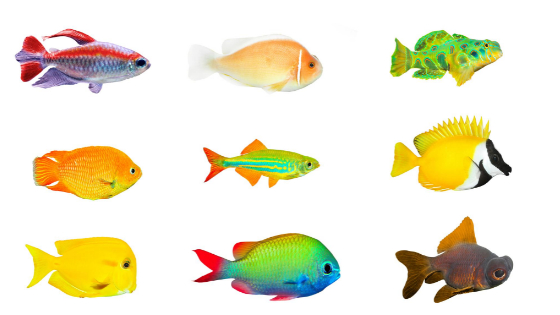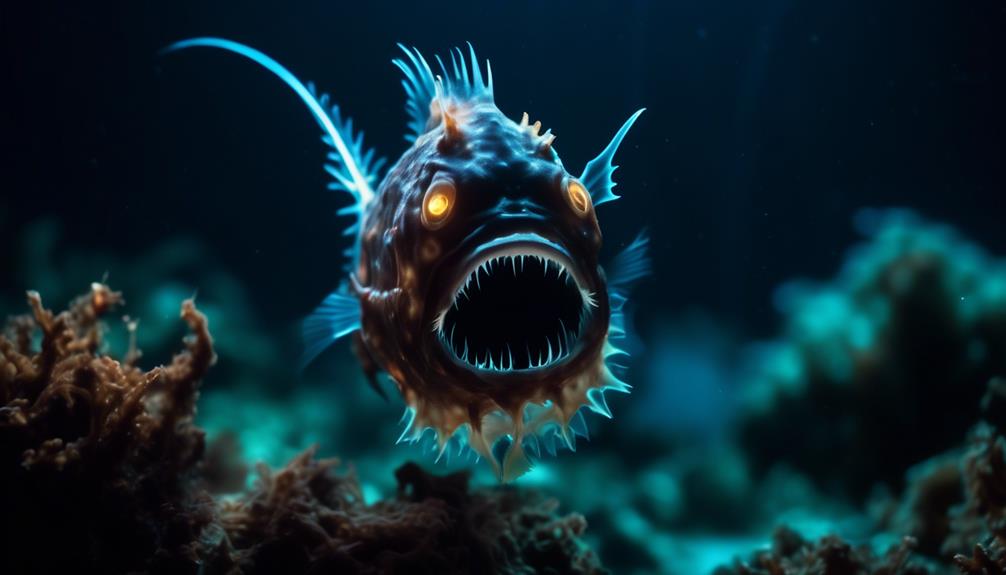
In the depths of the ocean, where darkness reigns and mysterious creatures dwell, the anglerfish lurks like a hidden gem, waiting to be discovered. With its bioluminescent lure and aggressive hunting tactics, this enigmatic predator captures the imagination of those who dare to venture into its world.
But what lies beneath the surface? What secrets does this rare and fascinating creature hold? In this article, we will delve into the captivating realm of the anglerfish, shedding light on its intriguing characteristics, unique care requirements, and mesmerizing behavior.
Prepare to be amazed as we take a closer look at these elusive creatures and unlock the mysteries that lie within.
Key Takeaways
- Anglerfish are a family of predatory fish with over 200 species, found in saltwater environments.
- They require a large aquarium with plenty of rock and coral cover, and prefer suitable tank mates or being kept alone or with another anglerfish.
- Anglerfish have an aggressive temperament and spend most of their time at the bottom of the aquarium.
- They thrive on live foods but can be trained to accept frozen foods, and require regular feeding to maintain their health.
General Information
Anglerfish, consisting of over 200 separate species, are a family of predatory fish found in saltwater environments. These medium to large-sized fish have an aggressive temperament and require a large aquarium of 50+ gallons.
Anglerfish swim in the bottom region of the water and prefer suitable tank mates or being kept alone or with another anglerfish. They originate in the North Atlantic Ocean and come in subdued shades of red, yellow, tan, orange, and black.
When it comes to maintenance and care, choosing tank mates for anglerfish can be tricky due to their predatory nature. They aren’t active swimmers and spend most of their time at the bottom of the aquarium. Proper filtration is important due to their significant waste production. Anglerfish are reef safe and can blend in with rock and coral cover.
In terms of feeding, they thrive on live foods such as small fish, brine shrimp, and ghost shrimp. They can also be trained to accept frozen foods.
Breeding anglerfish in home aquariums is unheard of, as their reproductive behavior involves the male attaching itself to the female and sharing her blood system.
Saltwater Habitat
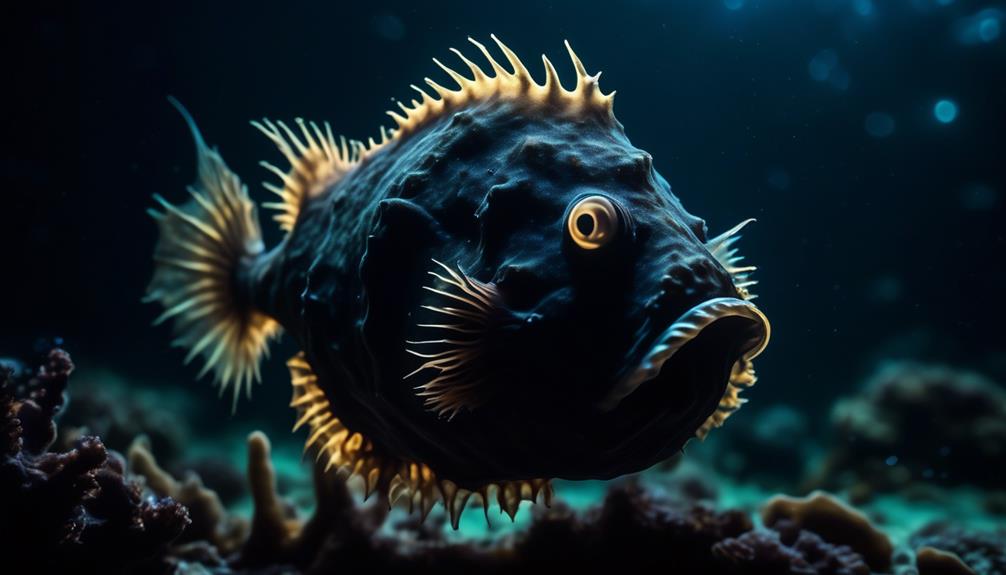
In their natural habitat, anglerfish thrive in saltwater environments. These fascinating creatures have adapted to life in the ocean and have some unique characteristics that make them stand out. Here are three interesting facts about the saltwater habitat of anglerfish:
- Deep-sea Dwellers: Anglerfish are predominantly found in the deep-sea regions of the ocean, where the saltwater is dark and cold. They’ve specialized adaptations that allow them to survive in these extreme conditions.
- Camouflage Experts: Anglerfish have the remarkable ability to blend in with their surroundings. Their skin color and texture help them camouflage amongst the rocks and corals, making them almost invisible to their prey and predators.
- Pressure Tolerance: The saltwater habitat of anglerfish can reach incredible depths, where the pressure is intense. These resilient creatures have developed a strong skeletal structure and a flexible body to withstand the immense pressure exerted by the water.
Through their unique adaptations and ability to thrive in saltwater environments, anglerfish have become some of the most intriguing inhabitants of the ocean depths.
Size and Temperament
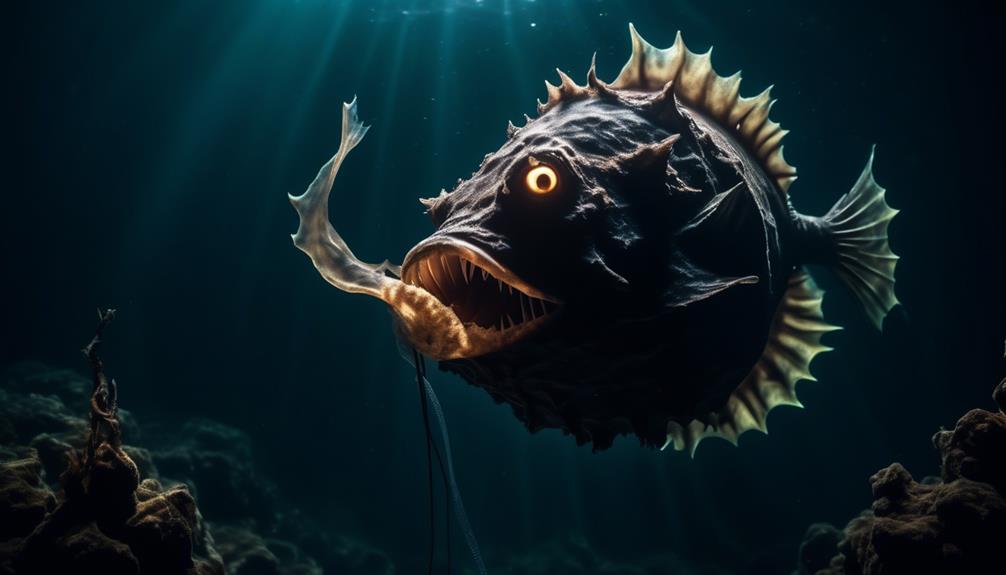
Thriving in their saltwater habitat, anglerfish possess a notable size and temperament that contribute to their captivating presence in the deep-sea regions. These unique fish can range in size from a few inches to over three feet long, depending on the species. Their large mouths and expandable stomachs allow them to consume prey much larger than themselves. Anglerfish also have a reputation for their aggressive temperament, using their sharp teeth and bioluminescent lure to attract and capture their prey. They are solitary creatures and prefer to inhabit the dark depths of the ocean, where their size and temperament make them formidable predators. Below is a table that summarizes the size and temperament of anglerfish:
| Size | Temperament |
|---|---|
| Medium to large | Aggressive |
Aquarium Requirements
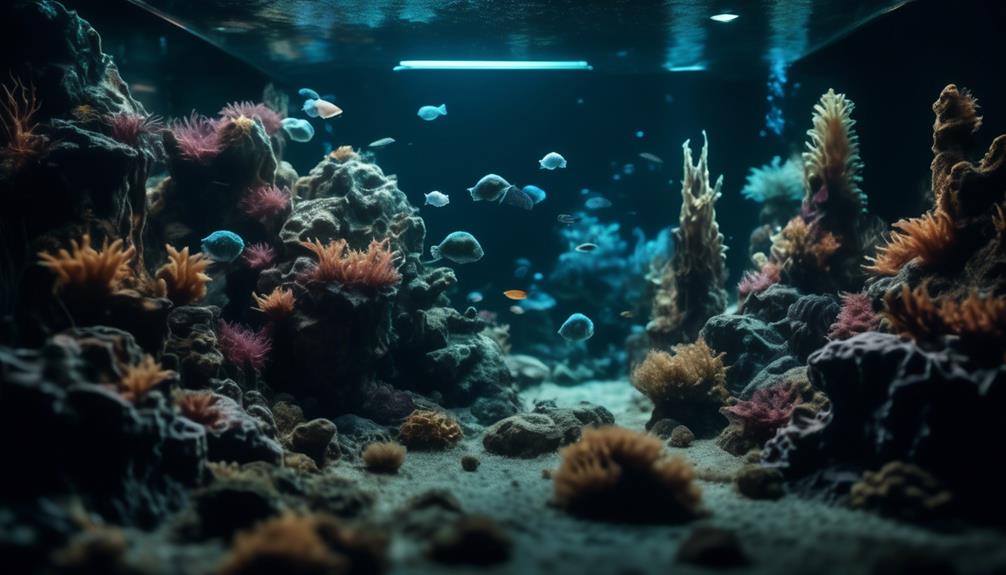
What are the specific requirements for maintaining an anglerfish in an aquarium?
Here are some essential considerations for keeping an anglerfish in your aquarium:
- Aquarium Size: Anglerfish require a large aquarium of at least 50 gallons due to their size and swimming habits.
- Tank Mates: Choosing suitable tank mates for anglerfish can be challenging due to their aggressive nature and vulnerability to larger, aggressive fish.
- Filtration: Proper filtration is crucial in anglerfish aquariums due to their significant waste production.
These requirements ensure that anglerfish are provided with an appropriate environment that meets their needs for space, compatibility with other fish, and water quality. By following these guidelines, enthusiasts can create a suitable habitat for these rare and enigmatic creatures.
Maintenance and Care

Taking care of anglerfish requires daily attention and knowledge of their specific needs. Anglerfish aren’t active swimmers and spend most of their time at the bottom of the aquarium, so it’s important to provide them with plenty of rock and coral cover to mimic their natural habitat. Proper filtration is crucial in their aquariums due to their significant waste production. Anglerfish are reef safe and can blend in with rock and coral cover.
When it comes to tank mates, choosing suitable companions for anglerfish can be challenging due to their predatory nature and vulnerability to larger, aggressive fish.
In terms of feeding, anglerfish thrive on live foods such as small fish, brine shrimp, and ghost shrimp. They can also be trained to accept frozen foods like krill and mysis shrimp. However, breeding anglerfish in home aquariums is unheard of, as their reproductive behavior is complex and occurs in their natural habitat.
Feeding Habits
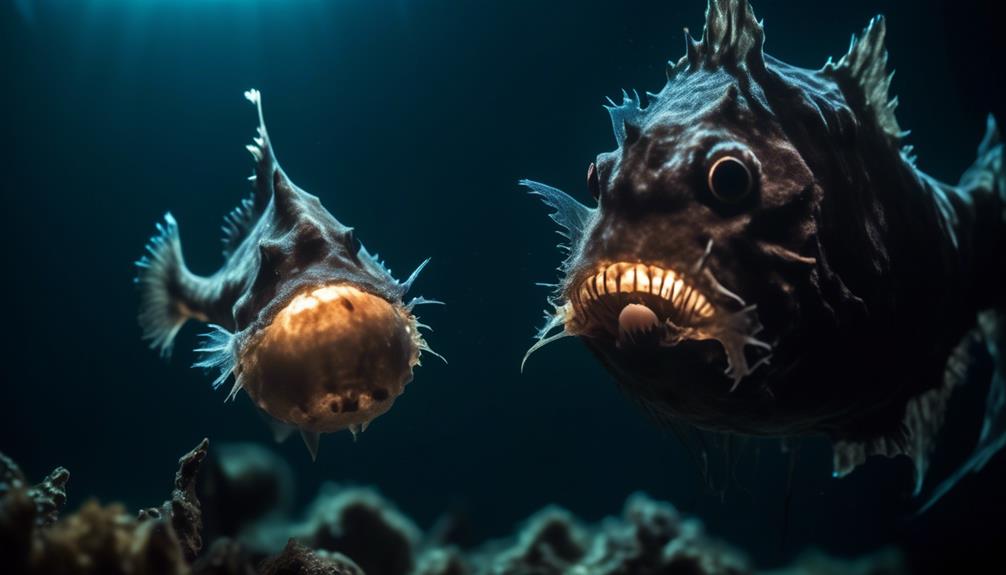
When it comes to meeting their dietary needs, anglerfish have specific feeding habits that require attention and consideration. Here are some key points about their feeding habits:
- Diet: Anglerfish thrive on live foods such as small fish, brine shrimp, and ghost shrimp.
- Frozen Foods: They can be trained to accept frozen foods like krill, mysis shrimp, and chunks of fish.
- Prey Drive: Stimulating their prey drive by wiggling food in front of them can encourage feeding.
Anglerfish aren’t active swimmers and spend most of their time at the bottom of the aquarium. Therefore, it’s important to ensure regular feeding to maintain their health and well-being. By providing them with the appropriate live or frozen foods and stimulating their prey drive, anglerfish can thrive in captivity.
Breeding Behavior
Anglerfish exhibit unique breeding behavior, characterized by the male attaching itself to the female and sharing her blood system in their natural habitat. This behavior is known as sexual parasitism, and it’s extremely rare among vertebrates.
The male anglerfish is much smaller than the female and lacks a functional digestive system. Once it finds a suitable mate, it latches onto her using specialized jaws and teeth. Over time, the male’s body fuses with the female’s, and their circulatory systems become connected. This allows the male to extract nutrients and oxygen directly from the female’s bloodstream.
In return, the male provides sperm to fertilize the female’s eggs. This extraordinary adaptation ensures successful reproduction for these enigmatic and fascinating creatures.
Varieties and Pictures
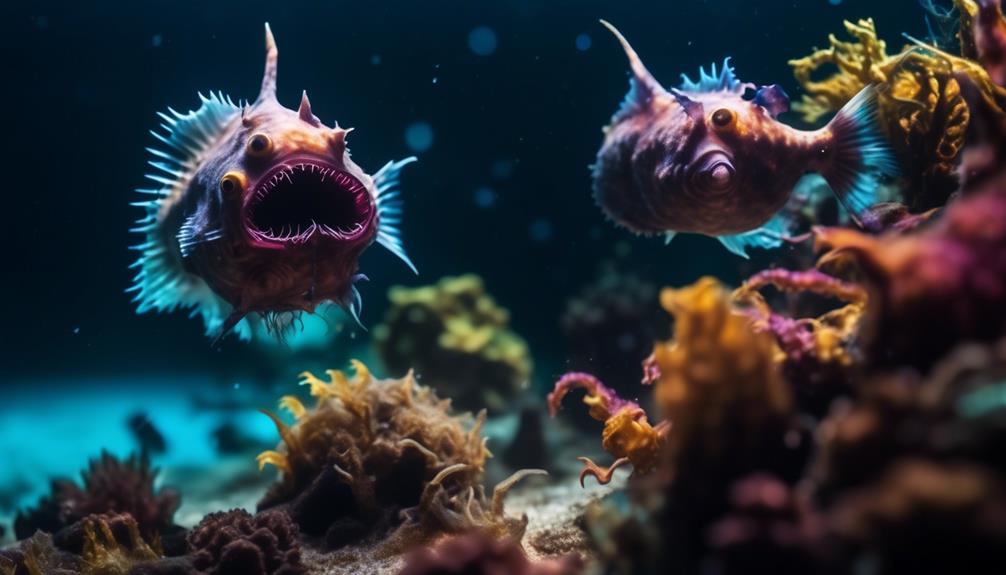
There are various varieties of anglerfish, each displaying unique characteristics and colors. These fascinating creatures come in a range of colors such as red, orange, yellow, tan, and black.
Here are three noteworthy anglerfish varieties:
- Assorted: This variety showcases a combination of vibrant colors, making them a visually stunning addition to any aquarium.
- Sargassum: Known for their ability to camouflage, Sargassum anglerfish blend effortlessly with their surroundings, resembling floating seaweed.
- Wartskin: These anglerfish have a distinctive appearance with rough, wart-like bumps on their skin, giving them a rugged and intriguing look.
To get a closer look at these amazing anglerfish varieties, check out the captivating photos taken by Daniel Dietrich/Flickr and Kinosakimarinwarudo. These pictures capture the unique features and beauty of these rare and enigmatic creatures.
Frequently Asked Questions
Are Anglerfish Suitable for Beginners in the Aquarium Hobby?
Anglerfish may not be suitable for beginners in the aquarium hobby due to their aggressive temperament, specific care requirements, and difficulty in finding suitable tank mates. They require daily care and a large aquarium.
Can Anglerfish Be Kept in a Reef Tank?
Yes, anglerfish can be kept in a reef tank. They are reef safe and can blend in with rock and coral cover. However, choosing tank mates for them can be tricky due to their predatory nature.
Do Anglerfish Require Specific Water Parameters in Their Tank?
Anglerfish require specific water parameters in their tank to thrive. Maintaining suitable temperature, salinity, and pH levels is crucial for their well-being. It is important to research and provide the appropriate conditions for these unique and enigmatic creatures.
How Long Do Anglerfish Typically Live in Captivity?
Anglerfish typically live for 5 to 10 years in captivity. Proper care, including suitable tank mates, regular feeding, and maintaining water conditions, can help ensure their longevity and well-being.
Are Anglerfish Prone to Any Specific Diseases or Health Issues?
Anglerfish are not prone to any specific diseases or health issues, but like all fish, they can be susceptible to common ailments such as bacterial or fungal infections. Regular maintenance and care are important to ensure their overall health and well-being.
What Can Anglerfish Teach Us About Discovering New Species?
Anglerfish can teach us valuable lessons about discovering new species. By delving into the ancient Chinese goldfish secrets of patience and observation, researchers can uncover unique and elusive creatures in the depths of the ocean. These secrets remind us to keep searching and learning, even when the task seems daunting.
Conclusion
In conclusion, the rare and enigmatic anglerfish continue to captivate and intrigue both marine enthusiasts and scientists with their unique characteristics and captivating behavior.
From their bioluminescent lure to their aggressive temperament, these predatory fish have carved a niche for themselves in the depths of the ocean.
With careful consideration of their specific needs and a deeper understanding of their feeding and reproductive habits, anglerfish enthusiasts can enjoy the mesmerizing allure of these fascinating creatures in their own aquariums.




